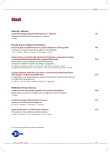Ascites in Mulibrey syndrome
Authors:
L. Husová 1; P. Husa 2
Authors‘ workplace:
Interní hepatogastroenterologická klinika Lékařské fakulty MU a FN Brno, pracoviště Bohunice, přednosta prof. MUDr. Jan Lata, CSc.
1; Klinika infekčních chorob Lékařské fakulty MU a FN Brno, pracoviště Bohunice, přednosta prof. MUDr. Petr Husa, CSc.
2
Published in:
Vnitř Lék 2009; 55(6): 604-607
Category:
Case Reports
Overview
The authors describe a case of 22 years old adult male with Mulibrey syndrome. This is an autosomal recessive hereditary disease that manifests through multiple malformations. Diagnosis of Mulibrey syndrome in the present case was first based on clinical signs (facial dysmorphia, growth disorder, muscle hypotrophy) and was later confirmed by genetic examination. At the age of 18 months, the patient underwent surgery for Wilms’ tumour followed by cytostatic therapy. Facial, neck and lower extremities oedemas started to occur from the age of 11 years when diastolic ventricular dysfunction was also diagnosed. Pericardiectomy was performed at the age of 13 with no significant clinical effect. Significant ascites dominated the clinical picture and required repeated paracentesis at the age of 15 years. Subjective complaints improved when adequate diuretic therapy was introduced and ascites was managed with conservative therapy without the need for further paracentesis.
Key words:
Mulibrey syndrome – Wilms’ tumour – constrictive pericarditis – ascites
Sources
1. Seemanová E. Mulibrey syndrom s výskytem Wilmsova tumoru. Čes Slov Pediat 2002; 57: 509–511.
2. Karlberg N, Jalanko H, Perheentupa L et al. Mulibrey nanism: clinical features and diagnostic criteria. J Med Genet 2004; 41: 92–98.
3. Kallijärvi J, Hämäläinen RH, Karlberg N et al. Tissue expression of the mulibrey nanism – associated TRIM37 protein in embryonic and adult mouse tissues. Histochem Cell Biol 2006; 126: 325–334.
4. Hämäläinen RH, Joensuu T, Kallijärvi J et al. Characterisation of the mulibrey nanism‑associated TRIM37 gene: transcription initiation, promoter region and alternative splicing. Gene 2006; 366: 180–188.
5. Hämäläinen RH, Mowat D, Gabett MT et al. Wilm’s tumor and novel TRIM37 mutations in an Australian patient with Mulibrey nanism. Clin Genet 2006; 70: 473–479.
6. Scott RH, Stiller CA, Walker L et al. Syndromes and constitutional chromosomal abnormalities associated with Wilms tumour. J Med Genet 2006; 43: 705–715.
7. Seemanová E, Bartsch O. Mulibrey nanism and Wilms tumor. Am J Med Genet 1999; 85: 76–78.
8. Avela K, Lipsanen-Nyman M, Idänheimo N et al. Gene enconding a new RING-B-box-Coiled-coil protein is mutated in mulibrey nanism. Nat Genet 2000; 25: 298–301.
9. Kivistö S, Lipsanen-Nyman M, Kupari M et al. Cardiac involvement in Mulibrey nanism: characterization with magnetic resonance imaging. J Cardiovasc Magn Reson 2004; 6: 645–652.
10. Lapunzina P, Rodríguez JI, de Matteo E et al. Mulibrey nanism – 3 additional patients and review of 39 patients. Am J Med Genet 1995; 55: 349–355.
11. Jagiello P, Hammans C, Wieczorek S et al. A novel splice site mutation in the TRIM37 gene causes mulibrey nanism in a Turkish family with phenotypic heterogeneity. Hum Mutat 2003; 21: 630–635.
12. Karlberg S, Tiitinen A, Lipsanen-Nyman M. Failure of sexual maturation in Mulibrey nanism. N Engl J Med 2004; 351: 2559–2561.
13. Karlberg N, Jalanko H, Lipsanen-Nyman M. Growth and growth hormone therapy in subjects with Mulibrey nanism. Pediatrics 2007; 120: e102–e111.
14. Lipsanen-Nyman M, Perheentupa J, Rapola J et al. Mulibrey heart disease: clinical manifestations, long‑term course, and results of pericardiectomy in a series of 49 patients born before 1985. Circulation 2003; 107: 2810–2815.
15. Perheentupa J, Leisti S, Autio S et al. Mulibrey nanism, an autosomal recessive syndrome with pericardial constriction. Lancet 1973; 2: 351–355.
Labels
Diabetology Endocrinology Internal medicineArticle was published in
Internal Medicine

2009 Issue 6
Most read in this issue
- The treatment of renal failure in multiple myeloma
- Is confirmation of an adrenal adenoma in patients with primary aldosteronism sufficient for indication of adrenalectomy?
- The case of familial adenomatous polyposis and a proposal for the system of dispensarisation
- Venous thromboembolism in an oncology patient
